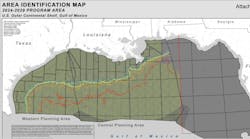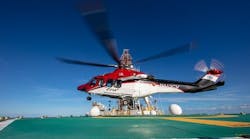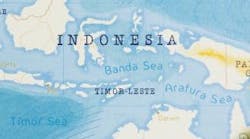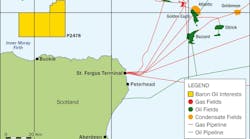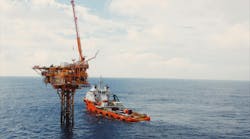David Paganie
Managing Editor
US domestic oil production last year posted its first increase since 1991, thanks to a handful of deepwater projects, most notably a full year of production at Thunder Horse, which accounted for an estimated 200 Mb/d or 26% of the growth. The BP-operated project also was a major contributor in increasing Gulf of Mexico output by over 30%. The field currently accounts for 15% of all GoM supply. However, Gulf oil production is expected to peak in 2011, followed by the beginning of a steady decline.
The good news is industry continues to make healthy discoveries, albeit not the size of Thunder Horse, but perhaps large enough to upright the forthcoming decline. We reported in the January edition ofOffshore (www.offshore-mag.com/index/current-issue/offshore/volume-70/issue-1.html) that the 2009 discoveries, announced through the end of November, represented nearly 1.4 Bboe, the most found in a single year in the GoM since 2002. Meanwhile, others are firming up previous finds.
There are a number of factors that dictate the timing and selection of projects to move forward, but for now, here are some possibilities.
New discoveries, appraisalsThe resource estimate from a new discovery on theLucius prospect and subsequent appraisal work has the field partners considering development options. Industry sources estimate the field to contain recoverable resources of about 150-200 MMbbl of liquids/oil and about 1 tcf of natural gas. Operator Anadarko says it will continue appraisal work in the area this year. Development options under consideration include a subsea tieback to the Red Hawk cell spar or standalone development.
Lucius, in Keathley Canyon block 875 in 7,100 ft (2,164 m) of water, was discovered in December 2009. Ensco 8500 drilled the well to 20,000 ft (6,096 m) TD and encountered more than 200 net ft (61 m) of pay in subsalt Pliocene and Miocene sands. A recent appraisal well was drilled up-dip to 20,600 ft (6,279 m) TD, approximately 3,200 ft (975 m) due south of the discovery well. It hit about 600 net ft (183 m) of oil and gas pay.
Lucius is 7.5 mi (12 km) east of Chevron's 2009Buckskin discovery on Keathley Canyon block 872. There, Buckskin No. 1 was drilled in 6,920 ft (2,109 m) of water to 29,404 ft (8,962 m) deep and encountered more than 300 ft (91 m) of net pay. Commercial viability is yet to be determined. Chevron plans to drill an appraisal well on Buckskin in the first half of this year.
Following work on Lucius, Anadarko will moveEnsco 8500 to the Heidelberg discovery for an appraisal program. The company also plans to drill a second appraisal well on its 2009 Vito discovery, which is estimated to hold greater than 200 MMboe. Field operator Shell is targeting FEED by next year, with an estimated startup post-2014. See page 22 in this issue for more details.
Anadarko also continues development at Caesar/Tonga. There, three of the four development wells have been drilled, and conversion work continues on the topsides of the host platform, Constitution. First production is expected in 2Q 2011. Anadarko says it expects to bring online six new "mega projects" by 2016.
Shell has made a discovery at theAppomattox prospect on Mississippi Canyon block 392. Development planning, which could include a new hub according to partner Nexen, is under way. See page 22 for more details.
Meanwhile, Nexen continues appraisal work on itsKnotty Head discovery in Green Canyon block 512, with results expected in the second quarter of this year. Ensco 8501 is drilling the well. One development scenario under consideration is an early production system for a number of subsea wells tied back to an existing platform in the vicinity. The other option is full field development immediately with water injection. First production is expected post-2014.
Shell has first oil from Perdido - the world's deepest spar in about 2,450 m (8,000 ft) of water, and the first Paleogene production ever in the Gulf of Mexico, the company says. The facility produces from the Great White, Silvertip, and Tobago fields, requiring up to 35 wells over the life of the fields. The Tobago subsea completion in 2,900 m (9,600 ft) of water holds the world depth record for a completed subsea well. In addition, all Perdido subsea fields will use subsea separation and boosting. The development is expected to ramp up to 100,000 boe/d. Photo courtesy of Shell.
A second deepwater rig, Ensco 8502, is expected to arrive in the middle of this year for Nexen. The company plans to use both rigs to drill up to four GoM exploration wells, including prospects Kakuna, Angel Fire, Solitude, and non-operated Catalina.
ERT has hit oil and gas pay at theJake prospect on Green Canyon block 490.
The discovery well, drilled by Ocean America to 13,504 ft (4,116 m) TD in 3,740 ft (1,139 m) of water, encountered 134 ft (41 m) of net oil and gas pay in a single sand interval. Development options include a potential joint project with a recent nearby discovery. First production is anticipated in mid-2011.
Mariner Energy has made a discovery at itsWide Berth prospect on Green Canyon block 490. The discovery well encountered approximately 130 ft (40 m) of net pay.
LLOG Exploration has hit 120 ft (37 m) net TVD of oil pay at theMandy prospect on Mississippi Canyon block 199. The discovery well was drilled in 2,500 ft (762 m) of water to 7,500 ft (2,286 m) TVD. A follow-up well on Mandy had similar results, striking more than 100 ft (30 m) net TVD of oil pay, LLOG confirms. The field's pre-drill estimate was about 10 MMboe. Mandy could be developed as a two-well subsea tieback to existing infrastructure, with production starting in 2011.
BP has confirmed an extension of its 2006Kaskida discovery. An appraisal well to test a western extension of the Kaskida field has confirmed oil in Lower Tertiary reservoirs 5 mi (8 km) west of the discovery well. The well, drilled to TD of 32,500 ft (9,906 m), is in Keathley Canyon block 291.
Appraisal work will continue with a wide-azimuth, towed-streamer seismic acquisition survey and a well test in 2011. Prior to the field extension confirmation, Kaskida was estimated to hold 3 Bboe in place. Project start-up is expected by 2015.
In September of last year, BP announced its second discovery in the Lower Tertiary, Tiber, which is said to be in the same class as Kaskida in terms of resource potential. Tiber, in Keathley Canyon block 102, is 50 mi (80 km) west-northwest of Kaskida.
The Tiber discovery well, in 4,132 ft (1,259 m) of water, struck oil in multiple lower tertiary reservoirs. It was drilled to 35,055 ft (10,685 m) TMD, making it the deepest well drilled ever, according to BP. Transocean's semisubmersible Deepwater Horizon drilled the well. BP said it would drill an appraisal well on field to determine its size and commerciality.
On the shelf, McMoRan Exploration Co. has made a deep well discovery at theDavy Jones prospect on South Marsh Island block 230 in 20 ft (6 m) of water. The well was deepened to 29,000 ft (8,839 m) TD in February. Logs indicated 200 net ft (61 net m) of hydrocarbon-bearing sands in four zones of the Wilcox section of the Eocene/Paleocene. McMoRan believes Davy Jones could be one of the largest shelf discoveries in the GoM in decades. The field is estimated to cover 20,000 acres, extending across four blocks. Pending the timing and results of the scheduled flow test and offset well, first production from Davy Jones is anticipated in 2011.
Possible project sanctionsFinal investment decision is expected by the end of this year for the development of the Chevron-operated Big Foot and Jack/St. Malo projects. Both projects entered FEED last year.
Chevron opted for FloaTEC's extended tension leg platform (ETLP) for the Big Foot development on Walker Ridge block 29 in 5,000 ft (1,524 m) of water. "A dry-tree development scenario with a full platform drilling rig was selected for the proposed Big Foot project as it will enable in-well artificial lift and timely intervention capabilities," Chevron tells Offshore. "Also, all wells, producers, and injectors can be drilled from a single drill center. The ETLP is well suited for a dry-tree scenario and its mooring system allows optimal placement of the drill center in the challenging seafloor conditions such as the one found in the deep waters of the GoM."
KBR secured the contract for topsides FEED.
Chevron also initiated FEED of a new hub to develop the Jack and St. Malo discoveries. The semisubmersible platform, with capacity to process 120,000-150,000 b/d of oil and 37.5 MMcf/d of gas, and provision for a future 200,000 b/d of water injection, will be moored in 7,000 ft (2,134 m) of water. Mustang won the contract for topsides FEED, with completion expected in the second quarter of this year.
Meanwhile, Enbridge has been contracted to extend the GoM's deepwater pipeline grid to transport oil from Big Foot and natural gas from St. Malo, Jack, and Big Foot.
Other projects that could get sanctioned this year include Tubular Bells, Mars B, Atlantis Phase 2, Galapagos, Na Kika Phase 3, Horn Mountain Phase 2, and Tahiti 2. Last year BP was considering a new hub as one of several development options for its Tubular Bells and Kodiak discoveries. The company appointed AMEC to evaluate the development options, with the aim of advancing the preferred solution into FEED. Mars B is in feasibility stage for a possible TLP with about 1,000 boe/d potential. Start-up is expected post-2014.
Projects on the drawing boards include Mad Dog Phase 2, Na Kika Phase 4, Atlantis Phase 3, Stones, and Cardaman Deep. Shell says Stones could hold up to 5 Bbbl of oil in place. The company is looking at early production options, with a project start-up post-2014. Shell said recently that its discoveries at Appomattox, West Boreas, Vito, and Stones, "underpin the potential for four new production hubs."
AlaskaThe MMS has approved, with conditions, Shell Gulf of Mexico's exploration plan to drill three exploratory, information-gathering wells in the Chukchi Sea of Alaska.
Shell proposes activities using one drillship, one ice management vessel, an ice-class anchor-handling vessel, and oil spill response vessels. The closest proposed drill site is more than 60 mi (97 km) offshore Alaska.
"Our approval of Shell's plan is conditioned on close monitoring of Shell's activities to ensure that they are conducted in a safe and environmentally responsible manner," says Ken Salazar, US Secretary of the Interior. "These wells will allow the department to develop additional information and to evaluate the feasibility of future development in the Chukchi Sea."
Meanwhile, Statoil has increased its acreage in the Chukchi Sea through acquisition of a 25% working interest in 50 ConocoPhillips leases. ConocoPhillips will retain operatorship and a majority working interest in the leases. Initial drilling on the leases is expected in 2012.
Statoil has contracted Fugro-Geoteam to acquire and QC process data from a 2,400-sq km (924-sq mi) 3D marine seismic program around the company's leases in the Chukchi Sea. The survey is planned for early August into October of this year.
CanadaIn Goldboro, Canada, preparations continue for the upcoming Deep Panuke construction program. Acergy is scheduled to begin offshore installation of the infield flowlines in the second quarter of this year. Meanwhile, Nova Scotia's first subsea tree was installed in late February at the Deep Panuke disposal well. Hydrogen sulphide and carbon dioxide from the field's natural gas will be disposed in this well during production.
First production from Deep Panuke initially was slated for late this year, but delays in the construction of the field's MOPU has pushed startup into 2011. The SBM-supplied platform is being assembled at Gulf Piping Corp. in Abu Dhabi. Fabrication of the platform legs is being done in the Netherlands, with CMP in Dunkerque supplying the riser caisson, and Aecon Fabco in Pictou, Nova Scotia, providing the flare tower.
More Offshore Issue Articles
Offshore Articles Archives
View Oil and Gas Articles on PennEnergy.com



